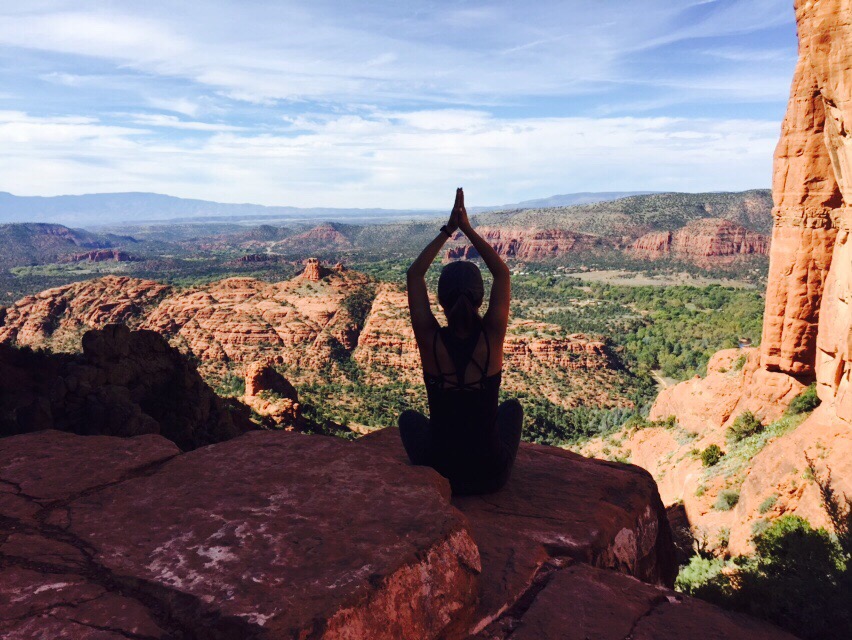Cultivating a daily meditation practice has so many useful benefits, including reduced anxiety and depression, mental clarity, and improvements in the functioning of physical and emotional systems, just to name a few. The increased self-connection we experience with regular meditation practice brings a sense of peace, compassion, and ease into our everyday life. It makes the world a better place to live in, not only for the meditator, but for everyone the meditator interacts with on a daily basis.
There are countless types of meditation, and they all have a powerful ability to improve your life. But generally speaking, certain techniques will resonate more with an individual than others— just like yogasana (yoga pose) practice. If you’re fairly new to the whole meditation thing, we recommend giving Mantra Meditation a try. It’s simple and accessible for everyone, and its intention can be adjusted daily to fit your current needs.
To practice mantra meditation, you’ll pick a word or phrase to focus on. The mantra itself (the phrase you choose) will become the focal point of your meditation.
Here are some examples of a mantra you can choose:
- May I know peace.
- I am calm and at ease.
- I surrender.
- I am happy, I am healthy, I am well.
- My heart guides me.
- I am here now.
…Really anything that is short, simple, and infused with intention will work!
- You can also sync your mantra up with your breath. For example:
- On your inhale: I am love.
- On your exhale: I give love.
- On your inhale: So
- On your exhale: Hum
***So Hum is a common Sanskrit mantra which means “I am That” and refers to identifying yourself as one with the Universe, or Ultimate Supreme Self. There are many Sanskrit mantras you can use for meditation, however as a beginner, this one is a great kicking-off point.
How to Practice your Mantra Meditation:
Find a comfortable position sitting upright in a chair, bed, or on the ground. We recommend sitting upright so as avoid the temptation of slipping off into sleep, but you can also lie down on your back if sitting isn’t an option. Just vow to stay present and awake!
Close your eyes and settle into your body and breath. Take a moment to feel your physical self in it’s current position; notice the sensations of the body, the temperature of the air, the surface beneath you.
Then bring your awareness to your breath. Allow your breath to become slow, steady, and calm.
Once you’ve taken that pause to connect into the present moment, you can get into your mantra. Begin reciting your chosen mantra, either syncing the words to your breath or solely focusing on the words themselves. Contemplate the meaning and connect to the soul of your mantra. Allow yourself to feel the truth of the words permeate through your being.
So hum.
So hum.
So hum.
So hum.
Continue as long as you’d like, but it’s preferable to spend at least five minutes here to gain the benefits. Whenever you notice the mind has wandered off into the past or future, simply and patiently guide it back to your mantra. It doesn’t matter how many times the mind wanders. The very fact that you notice it’s gone astray means you’re making progress in mindfulness.
How to Close your Meditation:
When you’re ready, come out of your meditation slowly. Take a moment to let the mantra fade from the forefront of your mind and again notice your body. Feel your breath. Become aware of any subtle shifts in your physical, mental, emotional being. Notice the immediate effects of your practice and bow your head in gratitude.
Then softly open the eyes, bring small movements to the body, perhaps take a few yoga poses to get back into the physical world, and go about your day refreshed and present!
Pretty simple, right? Try to take the time to practice at least three times a week, if not every day. The more you practice, the easier it will become, and the more benefits you’ll experience. Just like with your asana practice, consistency is key. If this particular style of meditation doesn’t do the trick for you, don’t fret. There’s something out there for everyone, and we’ll be sure to post more meditation techniques in the coming months, so stay tuned!
Reach out to your teacher if you have specific questions, comments, or concerns about your meditation practice. It’s not always easy, but with the right guidance and humble dedication, you can change your life, one meditation at a time.


wow so relieving,
very helpful
i also found something helpful
https://www.suzannesignaturesolutions.com/introduction-to-mantras/
thank you